Table of contents
- How are carburettors synchronized? A master car mechanic shows how it’s done
- “The work steps are always the same”
- A separate dial indicator for each cylinder
- Coordinate all clocks
- Idle synchronization
- Readjust mixture adjustment screws
- less petrol, more power, less wear
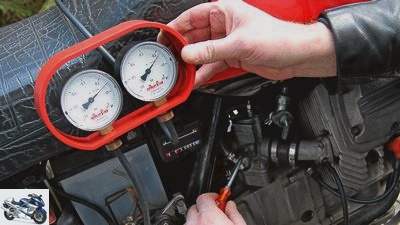
Schoch
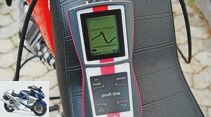

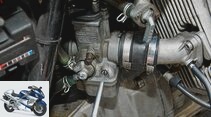

19th pictures

Schoch
1/19
A useful feature of digital synchronous clocks is the parallel representation of the suction processes (here: two curves lying one above the other). It allows conclusions to be drawn about the setting of the valves.
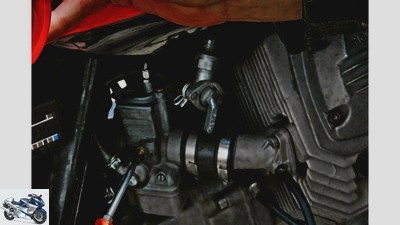
Schoch
2/19
After adjusting the mixture adjustment screw, the idle gas has to be readjusted from time to time.
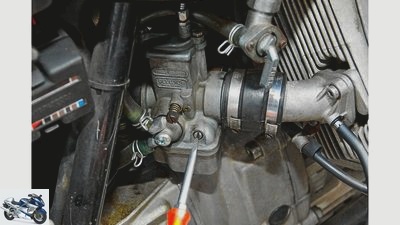
Schoch
3/19
With the mixture adjustment screw, the highest possible engine speed is set on each carburetor after synchronization.
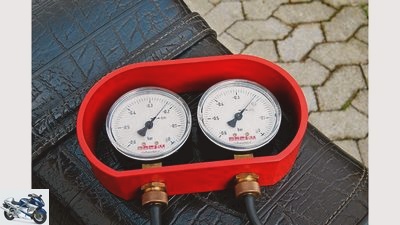
Schoch
4/19
Here the throttle cables of the Moto Guzzi are correctly adjusted. Both clocks react absolutely synchronously when accelerating.
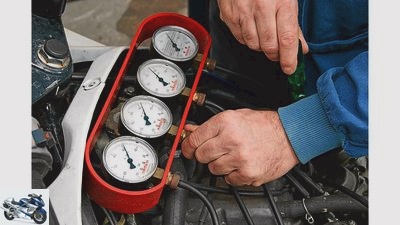
Schoch
5/19
While Klaus establishes the synchronicity of the carburettors, he carefully adjusts the damping of the clocks. Occasionally this may be necessary because the watches get warm during this procedure.
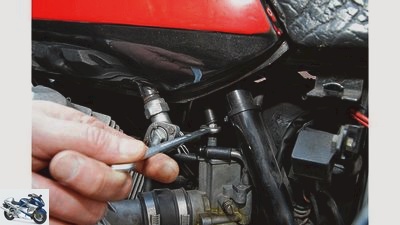
Schoch
6/19
… on the Moto Guzzi on the idle adjustment screw. Then the synchronicity of the throttle cables is set: here on both the Moto Guzzi and the Honda on the throttle cable play screws.
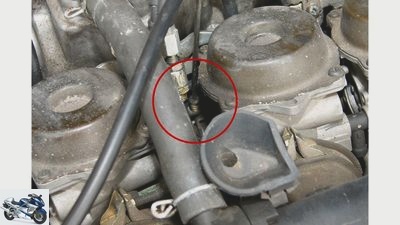
Schoch
7/19
First the synchronicity of the idle gas is established: On the 1000 Honda at the throttle valve stop (spring screw in the center of the circle), …
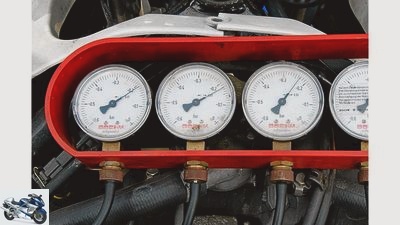
Schoch
8/19
The four carburettors of the Honda CBR 1000 F do not work synchronously when idling. If the setting is correct, the values displayed should be between minus 0.2 and 0.3 bar for all of them.
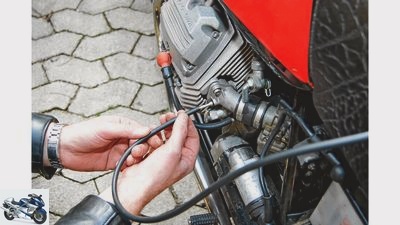
Schoch
9/19
The same applies when using adapters, as here with a Moto Guzzi V 35. Adapters and hoses must be tight!
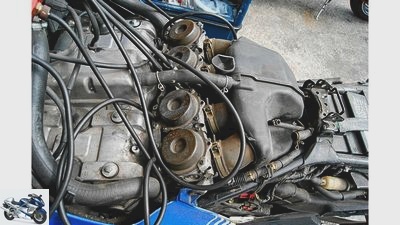
Schoch
10/19
The motor must be at operating temperature for synchronization. Then the vacuum hoses of all dial gauges can be connected (here on Honda CBR 1000 F).
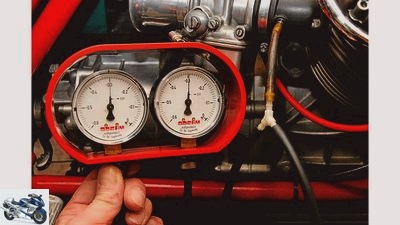
Schoch
11/19
The damping is adjusted using a fork hose connection that is included with the synchronous clocks.
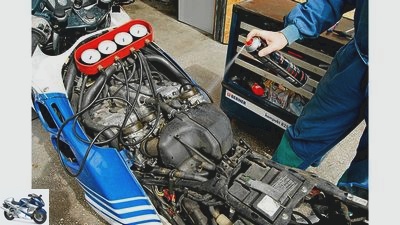
Schoch
12/19
With the engine running, Klaus checks whether the intake manifolds are tight. Simple trick: spray brake cleaner or start pilot onto the intake system. If the speed changes, the motor draws in external air.
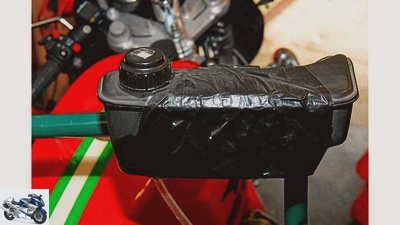
Schoch
13/19
On some motorcycles, the tank must be domonized to synchronize the carburetors. In order to have enough gasoline for the adjustment work, a makeshift auxiliary tank is very useful.
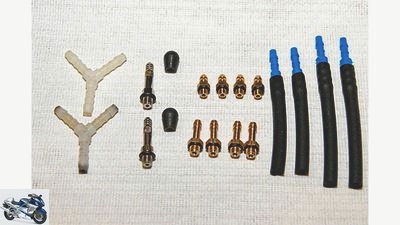
Schoch
14/19
In order to be able to warm up the motorcycle afterwards, the adapters are closed with the supplied rubber caps.
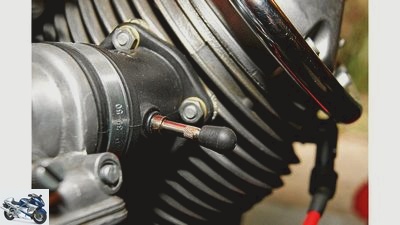
Schoch
15/19
If adapters are required, they should always be mounted on the cold engine.
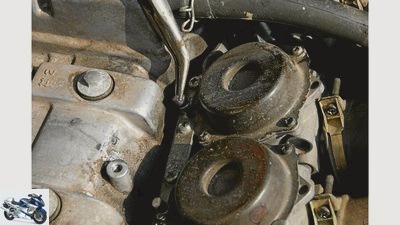
Schoch
16/19
Important: Adjust the free travel on the throttle cable to the correct dimension. To adjust, bring the engine to operating temperature. With some carburettor types, a rubber cap on the carburetor must be removed to connect the synchronous clocks.

Schoch
17/19
Klaus Steger, motorcycle expert and master car mechanic from Munich, shows how it’s done.
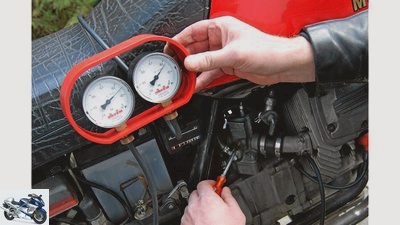
Schoch
18/19
One of the most important maintenance tasks on motorcycles is synchronizing the carburetors. If you can do this and have the right tools, you can prevent damage to the engine.
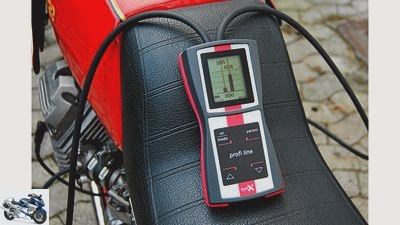
Schoch
19/19
Digital instruments: Today professionals often work with digital synchronous clocks. They have different modes and can also display the negative pressure as a bar chart. The sensitivity is preset electronically.
counselor
workshop
How are carburettors synchronized
How are carburettors synchronized?
A master car mechanic shows how it’s done
Content of
One of the most important maintenance tasks on motorcycles is synchronizing the carburetors. If you can do this and have the right tools, you can prevent damage to the engine. Klaus Steger, motorcycle expert and master car mechanic from Munich, shows how it’s done.
Marcel Schoch
07/19/2013
Checking the ignition and valve clearance as well as synchronizing the carburettors are part of the regular standard work on young and old-timers. While the first two maintenance points are often done by skilled screwdrivers themselves, they often neglect the carburetor synchronization. “For multi-cylinder motorcycles with more than one carburetor, however, the alignment of the mixture factories is extremely important,” warns Klaus Steger. “Only if all the carburettors work absolutely synchronously when accelerating can the cylinders build up and deliver the same force over the entire power range.” If, for example, only one of the four cylinders is out of line by opening too late or too early, the corresponding cylinder will develop Too much or too little force compared to the others. “In addition to a loss of power, poor idle gas and considerable vibrations, uneven mechanical loads can even cause bearing damage to the crankshaft and connecting rod,” says the experienced motorcycle expert.
Buy complete article
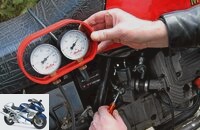
How are carburettors synchronized?
A master car mechanic shows how it’s done
4 pages) as PDF
€ 2.00
Buy now
“The work steps are always the same”
Most multi-cylinder engines usually have one carburetor per cylinder to prepare the mixture. In a few types, however, the mixture is fed from a carburetor through a forked intake port into the cylinders. Adjustment only has to be made here if several cylinder pairs are supplied via individual carburettors (Benelli 750 Sei).
For this work you need special negative pressure clocks (also called synchronous clocks) and, depending on the motorcycle, various hand tools and, if necessary, an external fuel supply. “The work steps are always the same,” explains Klaus. “First, the gas factories have to be checked for wear and tear and contamination. Intake nozzles and pipes must not suck in any outside air, and the air filter must be in order. ”Important: Check all cables for wear and tear or breaks. Kinked, crushed, or torn throttle cables must be replaced. Pay attention to the play on the throttle cable. “One to two millimeters is completely sufficient,” says Klaus. The same applies to throttle cable mechanics. They must also be free of play and run smoothly. Next step: checking valve clearance and ignition. If only one of the valves opens too late (too much play) or too early (too little play), the motor cannot be properly synchronized because the corresponding cylinder would be filled asynchronously. The ignition has a similar influence. If the ignition point is not optimal, the engine runs too slowly at idle, tends to die or runs too fast. So you should only go to the carburetor when the valve clearance and ignition are correct. This explains why all three points must always be tackled together.
A separate dial indicator for each cylinder
The intake vacuum is measured to synchronize the carburettors. In addition to mechanical negative pressure clocks, professionals also use digital devices or negative pressure columns that are filled with mercury or similar liquids. Vacuum clocks for two- and four-cylinder motorcycles are already available for little money in the relevant motorcycle accessories trade. Since a separate dial gauge is required for each cylinder, the corresponding number of watches should always be purchased. This is the only way to compare the various negative pressures in the intake manifold directly. Pay attention to quality when buying the watches. In particular, the damping of the pointer must be adjustable, otherwise an exact reading is not possible. “The damping prevents the hands from vibrating too much during synchronization,” explains Klaus. “The reason for this is the pulsating gas columns in the engine’s intake system.” Of course, the instruments should still be robust so that they can survive a fall without being damaged. Protective bars or rubber coatings prevent damage here.
To prepare for synchronization, the connections of the synchronous clocks on most motorcycles are screwed into the intake ports provided for this purpose, between the carburetor and the cylinder. A screw plug is located here at the factory, which must be unscrewed. On some motorcycles (e.g. BMW two-valve engines) the negative pressure is measured directly on the carburettor. Accordingly, there is a connection option here. When it comes to synchronizing the carburettors, however, it does not matter where the measurements are taken. If the hose adapter is screwed in, it is first closed with a rubber cap and then the engine is run at operating temperature. Tip: When buying the dial indicators, make sure that the correct adapter with suitable sealing caps is included. In the case of high-quality specimens, these can be supplied for almost all types of motorcycles.
Coordinate all clocks
“Before all the hoses are pushed onto the respective adapter, the dial indicators must first be coordinated with one another,” explains Klaus. “For this purpose, the clocks come with a fork connection that combines the vacuum hoses from two clocks into one line. The combined line must then be connected to a cylinder so that two synchronous clocks indicate an intake vacuum. Then start the engine and carefully turn the damper adjustment on both clocks until both react equally to the throttle without the pointers vibrating or trembling. ”If there are more than two clocks that need to be coordinated, this process must be carried out on all of them.
Once the clocks are coordinated, they are connected to the individual cylinders and the engine is restarted. Now every clock shows the current state of the vacuum situation in the intake port of the respective cylinder. If these differ, it is important to synchronize the idle first. However, there is no point in arbitrarily turning the idle adjustment screws in the hope of establishing synchronicity. That is why Klaus explains the principle: “The further the idle gas screw is turned out and the idle gas falls, the more the negative pressure in this cylinder increases. The opposite is true for the other cylinders – the negative pressure drops here. Once this principle is clear, the idle is synchronized very quickly. ”By alternately screwing in or unscrewing the respective idle adjustment screws in small steps, you finally achieve idle synchronicity.
Idle synchronization
“Of course, the idle speed of the engine must be observed here, around which the idle synchronization must take place,” adds Klaus. In doing so, one should orientate oneself on the specified target values of the manufacturer, which indicate how far the idle adjustment screws may be turned in or out as a maximum. Usually they are between half a and two and a half revolutions. If the engine runs synchronously in idle, the throttle cable play is checked again.
In order to then synchronize the throttle cables, the clocks must be observed when slowly and sensitively accelerating. The carburetor, whose synchronous clock reacts first with a significant drop in pressure, is the one whose throttle valve opens first. Similar to the idle synchronization, the throttle cable clearance adjustment screws of the respective or neighboring carburetor must then be carefully screwed in or out in small steps until both carburettors respond synchronously when accelerating. For engines with more than two cylinders, this procedure is continued until all carburettors work exactly the same. After synchronizing the carburettors, check the throttle cable play again. If work has been carried out correctly, it must be the same on all carburettors.
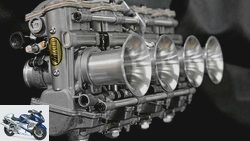
accesories
Stephen Topham – Grand Master of Mikuni Carburetors
The Swiss watch for motorcyclists
read more
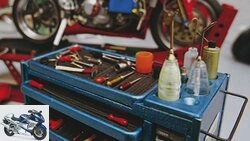
workshop
Big overview: repair everything to do with motorcycles
MOTORCYCLE screwdriver tips
read more
Readjust mixture adjustment screws
After synchronizing, the mixture adjustment screws still have to be readjusted. This happens when the engine is at operating temperature and idling. Use a suitable screwdriver to screw the mixture screw all the way into the carburetor. “If the engine almost dies here,” explains Klaus, “that is a good sign because the carburetor is sensitive to changes in the idle gas mixture. If nothing happens, it could be due to an incorrect idle jetting or setting. ”If the former is the case, you turn the screw to the target value according to the manufacturer’s instructions – usually two turns – and pay attention to the engine speed. Usually the engine runs as the idle gas was set. For fine tuning, the mixture adjustment screw is slowly turned up or down further. “After every small correction with a maximum of eighths of a revolution, you give the motor a few seconds to react,” explains Klaus. “If the engine starts to turn higher, you try to increase the speed with small corrections to the mixture adjustment screw up to the point at which it drops again.” Then the optimal setting for the carburetor has been found.
less petrol, more power, less wear
Under certain circumstances, the idle gas must then be readjusted or adjusted with the idle adjustment screws. Then the mixture of the next carburetor is adjusted in the same way until finally all of them have worked through. The setting of the mixture screws should always be within the manufacturer’s specifications. Normally this is between half a turn and a maximum of two and a half turns.
“The synchronicity of the carburettors should be checked regularly,” recommends Klaus, “because a well-tuned engine not only consumes less fuel, it also has more power and also runs with less vibration and less wear.” The intervals are based on the manufacturer’s instructions. However, it doesn’t hurt to check the synchronicity from time to time. Some will be surprised to find out how quickly this can change!
Related articles
-
Advisory: synchronize the carburetor
Schermer 5 pictures Schermer 1/5 Step 1: Preliminary work: To adjust the carburettors, they must be freely accessible. So down with the tank… Schermer…
-
Carburetor functionality in the video
Smartereveryday 49 pictures Schoch 1/49 If the engine does not immediately idle when you let go of the throttle grip, the ability of the throttle cable…
-
Schoch 20th pictures 1/20 Typical BMW 2V valve train. It looks similar on many other bumper engines. Schoch 2/20 To set the correct valve clearance, the…
-
Workshop – screwdriver tip for the inspection
Ralf Petersen 15th pictures Ralf Petersen 1/15 Every motorcycle must be serviced regularly if it is to function properly. Ralf Petersen 2/15 What is…
-
Restoration of the BMW R 80 G-S, part 3 structure, carburetor, electrics
Photo: Koch 10 pictures Cook 1/10 There are reasons why the R 80 G / S is back in the workshop after just a few hours. More about this in the MOTORRAD…
-
Adjusting the carburetor: the correct mixture composition
Schermer counselor workshop Adjusting the carburetor: the correct mixture composition Adjust the carburetor This is how the correct mixture composition…
-
Schoch 49 pictures Schoch 1/49 If the engine does not immediately idle when you let go of the throttle grip, the ability of the throttle cable to operate…
-
Change brake discs yourself – tips and tricks
Markus Jahn 9 pictures Ralf Schneider 1/9 There is a need for action here! The heat spots on the panes shown on the left can certainly no longer be…
-
Motorcycle production at Bimota
Jahn counselor traffic & business Motorcycle production at Bimota This is how one of the smallest manufacturers in the world produces Motorcycle…
-
archive counselor workshop Advisory: clean the carburetor Advice: clean the carburetor Clean the carburetor More than 90 percent of the motorcycles…